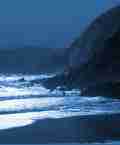 |
Search the site:

Walking Ireland’s MountainsThe South-EastThere was one particularly fine view over the inset Loch Muskry (a classic armchair corrie complete with water cushion) along to the cone of Galtymore. O'Loughman's Castle was very clear: a squat, square, crenellated tower until it is approached off Greenane when it disintegrates, as if by magic, into a crumbly conglomerate outcrop. It must be a place of legends. The small mountain ranges of the South-East are with one exception composed of either old red sandstone or Silurian rock. They are somewhat subdued in form but nonetheless surprisingly high, and boast one of Ireland's few Munros (peaks over 914 metres/3,000 feet high). Unusually for-Ireland, all the ranges are outside the ambience of the sea: they mostly rise from rich, well-populated, cultivated land and wide, coniferous plantations. One other general point: the Galtees, Knockmealdowns and the Comeraghs are quite close to each other, none too demanding and have plenty of varied accommodation around them. For these reasons they lend themselves to an easy week-long walking tour, though the absence of good maps (see below) makes accurate planning difficult. The Galtees (routes 1 to 3, 10) are a range twenty-five kilometres/fifteen miles long with a simple structure. The broad, gently sloped spine of the range runs east-west, culminating in Galtymore at 919 metres/3,018 feet. This is the only Munro, though the average height of the range is quite impressive. The western two-thirds of the range is the more interesting, with navigation greatly helped by an upland wall that runs along part of the main ridge Further east the range tends towards bland, gentle mounds. The views from the tops of the entire range are particularly extensive, though not spectacular, and cover an expanse of lowland to the north and the Knockmealdowns, and farther away a glimpse of the sea to the south. North of the spine are a series of fine, grassy, high-walled corries, three of which carry lakes. These northern slopes are extensively forested. The southern slopes are also much forested, though the gradient is gentler. Tiny partly wooded glens (in their higher reaches no more than grassy ravines) add greatly to the attraction of this side. Access from the south is by lengthy ascents on rough roads. Unfortunately, the mapping of the Galtees is particularly poor. A marathon east-west walk along the Galtees is organised for August of each year.
|
[ Back to Top ]
All Material © 1999-2004 Irelandseye.com and contributors
